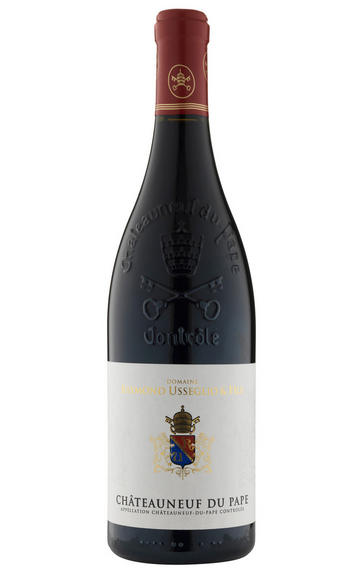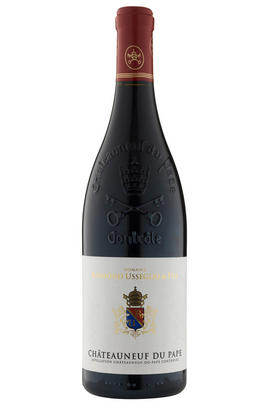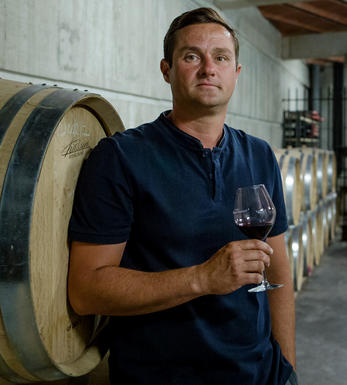
2022 Châteauneuf-du-Pape Rouge, Domaine Raymond Usseglio & Fils, Rhône

Critics reviews
80% Grenache, 10% Mourvèdre, 6% Syrah, 3% Cinsault and 1% Counoise. Partially destemmed and vinified in concrete tanks. Aged in a mix of foudres, old oak barrels and concrete tanks. Certified organic and biodynamic. Tank sample.
Tasted blind. Primary nose – damson and plum notes. A liquorice note and fine, chewy tannins. An attractive leather note and sweet spice. Well-judged oak and a rich, powerful finish.
Drink 2028 - 2040
Alistair Cooper MW, JancisRobinson.com (October 2023)
The promising 2022 Chateauneuf du Pape (tasted from tank) boasts effusive cherry, stone fruit and garrigue notes. Full-bodied and silky-textured, it looks to be an excellent vintage for this cuvée, finishing with great length and elegance.
In 2021, Usseglio said, "We were lucky to not get frosted—only five out of 25 hectares were affected." Of course, he and his pickers had to dodge the same raindrops as everyone else during harvest, but his 2021s have turned out really well. In 2022, he said, "We had a good winter, then it was very dry, with small berries. With the coolish nights, the vines didn't stop—we already had finesse at the end of August. The ferments went fast, malolactic was quick [and] the wines are accessible early, like 2007."
If the wines really turn out like 2007, the 2022 vintage could be one for the ages—and not just at this domaine.
Drink 2024 - 2035
Joe Czerwinski, Wine Advocate (September 2023)
Black cherry-infused thick ripe fruit, this is punchy for a Tradition cuvée. Not overly ripe or overly alcoholic however, just muscular and powerful. Not the most complex perhaps, but likely to be a good value option for those who like bold, thunderous Châteauneufs.
Drink 2026 - 2032
Matt Walls, Decanter (September 2023)
Leading off the reds with the 2022 Châteauneuf Du Pape (mostly Grenache with small amounts of Syrah, Mourvèdre, Cinsault, and Counoise), it has a pretty, perfumed, elegant, and medium-bodied style to go with a floral perfume of sweet raspberry and cherry fruits, notes of baking spices and peppery, Provençal garrigue, fine tannins, and a great finish. It's a great example of the quality and style of this estate today. It will drink nicely in its youth yet evolve for 10-15 years if well stored.
Jeb Dunnuck, JebDunnuck.com (October 2023)
About this WINE

Domaine Raymond Usseglio
This third-generation family domaine, of Italian origin, is today run by Raymond’s son, Stéphane Usseglio. The estate counts 24-hectares in Châteauneuf-du-Pape, all of which have been managed biodynamically since 2011. Their vineyards are divided equally between the galet-strewn parcels around Orange, the sandy soils of Courthézon and the alluvial, clay soils of the Crau plateau and the village of Bédarrides. Stéphane continues to innovate, using small, new oak barrels alongside the traditional foudres, as well as experimenting with concrete and terracotta amphorae of varying shapes and sizes. These winemaking techniques enhance the characteristics of each grape variety, carefully highlighting the particularities of each.
Stéphane’s 2021 wines are a great success, albeit 20-25% down in volume against their average yield. The wines show their trademark power and structure; but as we’ve seen with other producers, they also have lower levels of alcohol and higher acidity than the last two vintages. While this freshness makes them more approachable in youth than in some years, their structure will ensure they are nonetheless worthy of cellar ageing. They are wines to return to throughout their ageing process.

Châteauneuf-du-Pape
The most celebrated village of the Southern Rhône, Châteauneuf-du-Pape is the birthplace of the now indispensable French Appellation d’Origine Contrôlée system – imperfect though it may be. Compared to the Northern Rhône, the vineyards here are relatively flat and often feature the iconic galet pebbles – the precise benefits of which are a source of much debate. Minimum alcohol levels required by the AOC are the highest in France, but at 12.5% it is well below the natural generosity of Grenache, which only achieves its full aromatic potential when it is fully ripe and laden with the resultant high sugars. Syrah and Mourvèdre contribute the other defining elements in the blend, adding pepper, savoury spice and structure to the decadent Grenache. There are a further 10 permitted red grape varieties which can be used to adjust the “seasoning”. Of the five white varieties permitted, it is Grenache Noir’s sibling – predictably perhaps – Grenache Blanc, which dominates, though Roussanne shows a great deal of promise when handled well, notably at Château de Beaucastel.

Grenache/Garnacha
Grenache (Noir) is widely grown and comes in a variety of styles. Believed to originate in Spain, it was, in the late 20th century, the most widely planted black grape variety in the world. Today it hovers around seventh in the pecking order. It tends to produce very fruity, rich wines that can range quite widely in their level of tannin.
In many regions – most famously the Southern Rhône, where it complements Syrah and Mourvèdre, among other grapes – it adds backbone and colour to blends, but some of the most notable Châteauneuf du Pape producers (such as Château Rayas) make 100 percent Grenache wines. The grape is a component in many wines of the Languedoc (where you’ll also find its lighter-coloured forms, Grenache Gris and Blanc) and is responsible for much southern French rosé – taking the lead in most Provence styles.
Found all over Spain as Garnacha Tinta (spelt Garnaxa in Catalonia), the grape variety is increasingly detailed on wine labels there. Along with Tempranillo, it forms the majority of the blend for Rioja’s reds and has been adopted widely in Navarra, where it produces lighter styles of red and rosado (rosé). It can also be found operating under a pseudonym, Cannonau, in Sardinia.
Beyond Europe, Grenache is widely planted in California and Australia, largely thanks to its ability to operate in high temperatures and without much water. Particularly in the Barossa Valley, there are some extraordinary dry-farmed bush vines, some of which are centuries old and produce wines of startling intensity.


Buying options
Add to wishlist
Description
Usseglio’s flagship cuvée blends five grapes from five terroirs – 80% Grenache, 10% Mourvèdre and 10% a blend of three other Rhone varietals. Oak-aged Syrah adds complexity. The rest is aged in concrete, and 100% destemmed. The result is full-bodied and bursting with red cherries and ripe nectarines with a hint of pepper. The texture is silky-smooth, with beautiful freshness and a strong tannic finish.
Drink 2024 - 2034
Berry Bros. & Rudd
wine at a glance
Delivery and quality guarantee